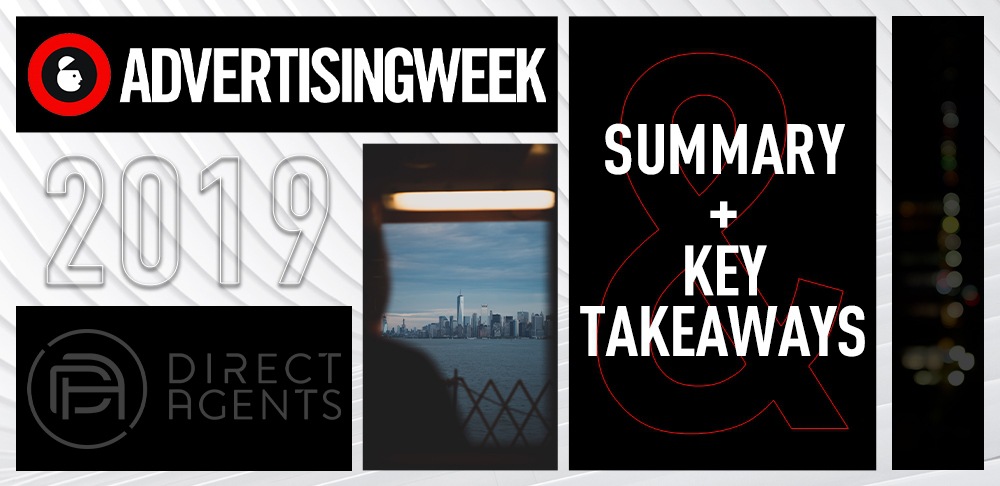Advertising Week 2019 has wrapped, and with nearly 300 events over the course of four days, I think we’ve all earned the gallons of free AMC popcorn that we consumed throughout the week. Having worked almost exclusively with Direct to Consumer and Video on Demand brands in my five years at Direct Agents, I was eager to listen in on panel discussions surrounding data and streaming, the power of brand-building, and on a more personal note: women’s sports. My take is below.
Panel: From TV to Digital – and Back: Why DTC Brands Rewrote Their Media Strategies
This session focused on the trend of DTC brands shifting strategy from performance-focused campaigns to broader reaching awareness tactics, specifically from digital channels to linear TV. The conversation focused on digitally-native DTC brands like Warby Parker, Touch of Modern, Untuckit, and Book of The Month Club. John Lippman, BOTM CEO and a member of the panel, said that his company turned to TV advertising once they had saturated performance channels like Facebook and Instagram, and needed the mass reach and scale that TV offers.
The most important thing for brands to keep in mind when introducing awareness tactics, be it TV, sponsored content, or even OOH, is that the KPI’s won’t line up with your performance campaigns. There are multiple points of entry for a brand to consumers and there needs to be different cost thresholds associated with each. BOTM entered the TV market knowing that it wouldn’t have the same immediate ROI as lower-funnel tactics, but that the long-term effects on LTV would be worth the investment.
Key Takeaway: A new awareness tactic buzzword: “future-proof”
Digiday’s recent article “‘Cultural mismatch’: Agencies are having trouble working with DTC brands,” notes that DTC brands are used to performance marketing and attributing every dollar spent to a dollar earned; so for many DTC brands, the shift to long-term brand-building (“future-proofing”) over short-term performance will be a tough pill to swallow.
Panel: The Streaming Wars Paved the Way For an Ad-Supported OTT World
The hot streaming topic of this panel was data and what might happen if we, the advertising industry, lose access to it. The gist is that most consumers have been opting in to sharing data when setting up smart TV’s in the same way that we agree to all of the T’s and C’s when setting up a new phone – we just click “yes” without actually knowing what we’re agreeing to. If, like me, you don’t actually take the time to read all of that fine print, as the Washington Post recently put it- you have given your TV permission to watch you back. Because of that, your TV is sharing info about what is coming across the screen, leading to better targeted ads and a treasure trove of audience data ripe for the using, or misusing.
Key Takeaway: If more states follow in California’s stricter GDPR footsteps, brands, agencies, and tech companies alike will feel the impact.
Panel: The Intensity of Fandom: A Look Inside the Relationship Between Fans & Brands
Presented with Disney Ad Sales, the fandom panel focused on Disney brands Marvel and ESPN, both with massive followings, or “fandoms.” The panel’s conversation focused on what makes someone a fan vs. what would cause someone to leave a brand, and what we as marketers can do to cultivate and care for brand fandoms.
Christina Hanson, Global Chief Strategy Officer at OMD, said the main reason someone will desert a brand is if something goes wrong and there is no explanation to the fans, or if something happens that goes against a fan’s or the brands’ core values. Conversely, if something upsets fans and a brand owns up or offers some kind of rational or action, it can help to strengthen the bond between fan and brand. Shane Rahmani, SVP and GM of New Media at Marvel and John Lasker, VP of Digital Programming at ESPN, both agreed that brands need to self-moderate in spaces where fans interact like social media to ensure that the fandom is living up to the brand standards.
When it came time for the age-old question of how brands justify spending ad dollars on brand-building, the panel unanimously agreed that a media mix of short and long-term tactics are needed, and that ignoring either one comes at the detriment to the brand overall.
Key Takeaway: A great branding campaign highlights the role a brand plays in a customer’s or a fan’s day-to-day life.
Panel: Women Worth Watching
After failing to get into two events with insanely long lines, I happily found myself listening in on the Women Worth Watching panel, which opened with the shocking statistic that only 4% of sports coverage is women’s sports. Panelists agreed that the issue is a bit of a chicken-and-egg situation. Media coverage follows fans, so for media to cover women’s sports, there needs to be fan engagement, but for there to be fan engagement, there needs to be media visibility.
Key Takeaway: We should all be buying tickets to women’s sports a lot more often, not just when they are having a moment, like women’s soccer is now.
Speaking of women worth watching, if you haven’t seen Megan Rapinoe’s acceptance speech after taking home the Best FIFA Women’s Player of The Year, it is most definitely worth watching.
– Brittany Lange, Director of Client Services, Direct Agents



